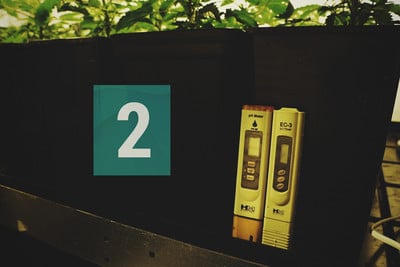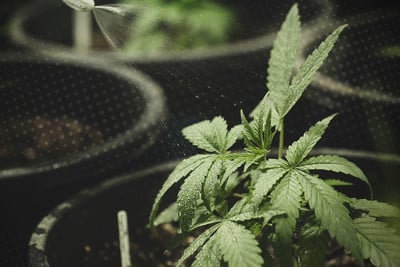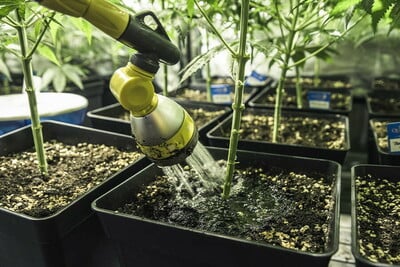.

How to Grow Cannabis With Reverse Osmosis (RO) Water
We all want the best for our cannabis plants, and purified water can help us provide. Here we look into reverse osmosis, and explore the benefits it can offer us in our cannabis growing pursuits.
Contents:
Plants love water—it’s no secret. Given that watering is one of your most vital roles as a grower, and that plants receive their food this way too, we all want our weed to drink the very best water possible.
Many growers opt for purified water, especially if employing hydroponic techniques. There are different purification methods available, but reverse osmosis is one of the most effective and reliable. But what is it, and is it worth it?
What Is Reverse Osmosis?
Reverse osmosis (RO) is a type of filtration process used to purify water. By using a semipermeable membrane, even dissolved solids are able to be removed from a water source, theoretically making it perfectly pure. In practice, however, particles down to as little as 0.001 microns (1 micron = 1 millionth of a metre) can be removed.
This makes it a highly effective filtration process, able to remove almost all bacteria, viruses, and dissolved solids from water. Some dissolved gases tend to be the only things able to permeate an RO filter.
RO is not just used in horticulture. In fact, it's mostly used to purify drinking water, sometimes on a huge scale. Desalination plants—where salt is removed from sea water—employ RO. Many nations around the world rely on RO to provide enough water for their populations. On a smaller scale, many homes are fitted with RO systems to purify their drinking water. So why not treat your cannabis plants to it too?
-
How Does Reverse Osmosis Work?
The process of osmosis describes a solvent’s (in this case water) tendency to move through a semipermeable membrane from an area of low solute concentration into a high one. That is, from an area with more water into an area with less. This is how cells stay hydrated. Water moves through the cell membrane until the water potential inside and outside the cell is the same—until there is equilibrium. The same goes for compounds such as calcium, potassium, and so on, which dissolve in water.
But what is reverse osmosis? Using significant pressure, water is forced through a semipermeable membrane from an area of high solute concentration into a low one, thereby reversing the process of osmosis.
Usually, in relation to cannabis, RO is associated with hydroponic setups. However, RO can be used to filter water for soil-grown cannabis plants as well.
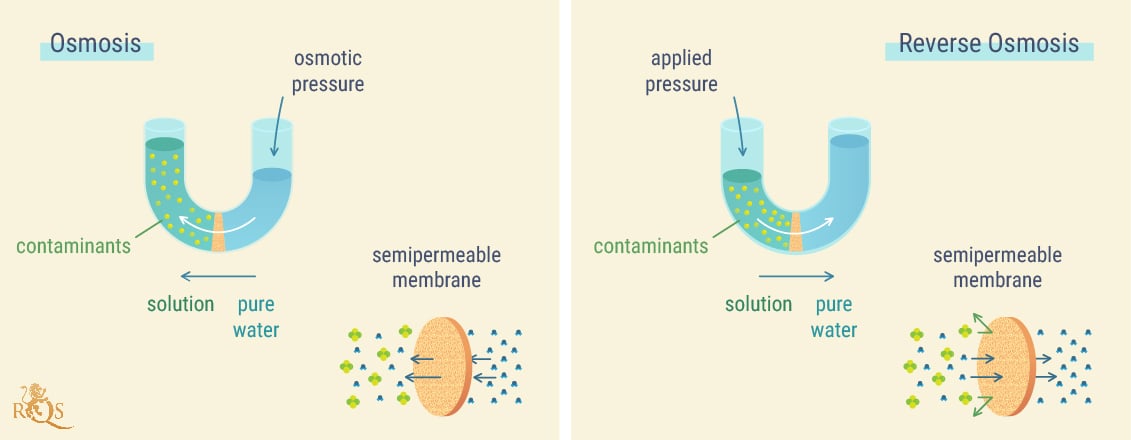

-
Reverse Osmosis vs Distilled Water for Cannabis Plants
Distillation involves boiling water, collecting the purified vapor, and then condensing it. Much like RO, distillation can remove almost all contaminants from your water. But which is better for your marijuana plants?
In terms of the final product, both methods will deliver near-pure water, to which you can add your nutrients and hydrate/feed your plants. In that case, other factors can help you determine which is right for your setup.
To start, distillation can be a little cheaper than RO, but requires a larger setup and cannot be connected to your existing water lines. It’s much more involved. RO systems, on the other hand, can be integrated into your plumbing, meaning you can just turn on the tap and have yourself some purified water.
So price, simplicity of integration, and water quality are all factors when deciding between the two. However, if you’re growing hydroponically, an RO system is almost certainly going to be the better option, as it can be integrated right into your existing system.
Why Does Reverse Osmosis Matter for Growing Cannabis?
There are several reasons incredibly pure water can be beneficial for your cannabis cultivation endeavours.
Most water sources already have minerals and nutrients dissolved in them, which can be measured with an electrical conductivity meter (EC meter). But it's very difficult to accurately determine the existing ratios of nutrients, making the process of adding additional nutrients much less accurate to boot.
However, by removing all impurities from your water, you start at zero, and are then able to achieve the perfect nutrient balance for your plants.
Perhaps even more importantly, purifying your water removes potentially toxic chemicals or dangerous pests, which at the very least will improve the health of your plants, and at the most could save their lives.
-
Benefits of Reverse Osmosis
RO may not be essential for most grows, but it can be a great way to get the very most from your plants. Here are the key benefits of RO water for cannabis:
✔️ Removes contaminants and pests
✔️ Allows for perfectly balanced nutrition
✔️ Very convenient for hydroponic grows
✔️ Can be integrated into your existing plumbing
✔️ Only requires maintenance every 2–5 years
✔️ More convenient than distillation
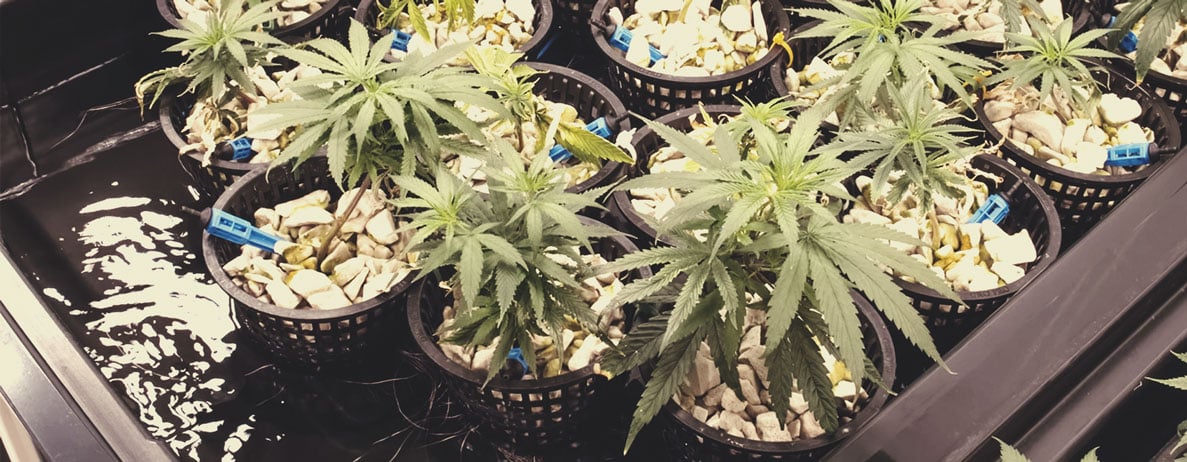
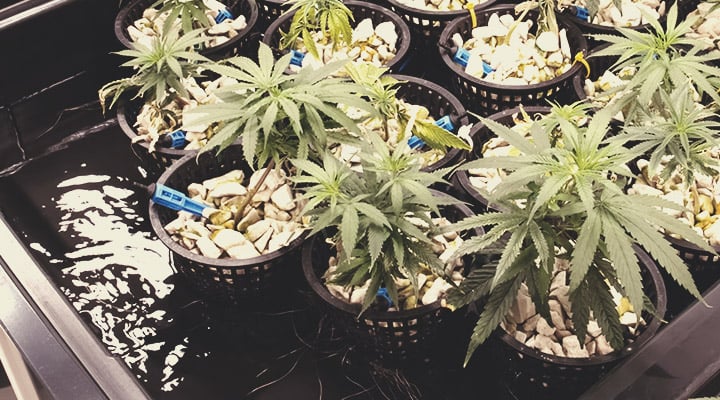
Reverse Osmosis for Cannabis: Practical Advice
This is where budget and integration really come into play. You needn’t go to the lengths of having an RO system installed. Rather, you could just buy RO purified water elsewhere. Whether this is a good option depends on how much cannabis you intend to grow, and whether you’re growing hydroponically or in soil.
-
Purchase Reverse Osmosis Water
RO purified water can be bought online and delivered to your door. The best places to look are on sites dedicated to either horticulture or aquariums. Prices vary, but average around £1 a litre, so it needn’t be too expensive. However, if you’re growing hydroponically, it’s likely having a filter installed will work out cheaper in the long run.
Depending on where you live, you may be able to fill up on RO water in certain stores. Common in the US, this method can be convenient, and can save on packaging too!
-
Instal Reverse Osmosis System
There are many instances in which having access to unlimited RO water is going to be convenient. Even outside of growing, you might use this as an opportunity to introduce purified water into your own life, as well as your plants’.
An RO system will likely cost you around £400. Maintenance costs aren’t massive, with filters needing to be replaced every few years. The maths isn’t too difficult. If you’re going to use over 400 litres of water in your cannabis growing adventures, an RO system might be a better call.
-
Nutrients for Reverse Osmosis
As mentioned, there will be no nutrients in your RO water—none at all. This provides a benefit to most growers, as you’re able to dial in the exact ratios you’re trying to achieve. Nevertheless, there are some basic minerals present in most water sources that will need to be added again, and without which your plants will suffer.
Specifically, you’ll be lacking calcium and magnesium (between other ions). To rectify this, buy a CalMag additive and get your water up to the recommended levels written on the tag of your desired product.
Another method is to use about 80% RO water and 20% tap water. While this might seem counterproductive after going to the effort to purify your water, it will deliver some essential nutrients while retaining a high degree of purity. Whether this is a viable option for you depends on the quality of your tap water.
With treated water, you’ll also need to add salts and keep a careful eye on the pH level. Super-pure water is useless if it actually blocks your plants’ roots from absorbing the nutrients you add to it. pH-up and/or pH-down solution might be necessary to get it back to a place that's beneficial.
Is a Reverse Osmosis Water System Good for Plants?
If you’re thinking of using RO water for cannabis, there are a few things to consider. It comes with the obvious benefit of removing contaminants and impurities from your water, rendering it safe to use. But it also takes almost all of the elements out of your water too, giving it zero mineral profile.
Therefore, RO water is not inherently “good” for your plants. In fact, alone it is probably worse than normal tap water. What it does give you is a starting point from which you can perfect the nutrient balance of your solution. This is why RO filters are popular in hydroponic grows, as hydro setups require highly controlled and specific conditions.
For soil grows, such levels of purity are less important, as the soil does much of the work itself. While well-adjusted RO water can be beneficial, poorly adjusted RO water is going to do more harm than good. So before looking to use totally pure water, ensure you have the skills, equipment, and energy to make up for what you’ll remove.


























